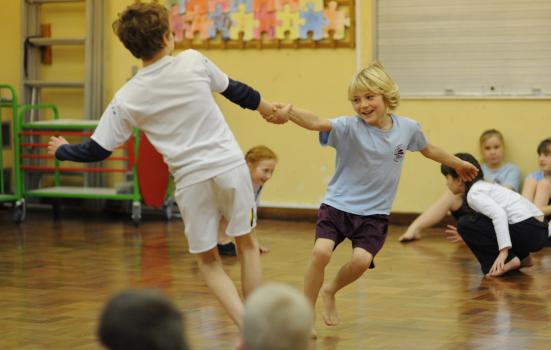The government’s new primary sports funding will increase dance provision in primary schools. Sally Fort urges dance practitioners and companies to get involved.

Brian Slater
Artsmark, the flagship programme which recognises schools and educational organisations for their commitment to high-quality arts and cultural education, has highlighted that less curriculum time is spent on dance than any other artform in primary schools. The good news is that from this academic year schools with primary-aged children can benefit from the government’s new primary sports funding, offering a new lifeline for dance education in schools. The new funding must be spent on improving PE (where dance provision often sits) and, depending on the number of pupils, schools are entitled to up to £8,000 or around £500 per pupil.
Alice Young, head of arts programmes at Trinity College London, which delivers Artsmark on behalf of Arts Council England (ACE), says: “This new funding gives schools a fantastic opportunity to support dance in the curriculum, in turn opening doors for dance practitioners and organisations to get involved in helping schools develop their dance provision. We see many applications for Artsmark status identifying dance as the artform they most want to develop and build upon in their school. With this funding opportunity, dance organisations can play an increasing role in supporting this through sustained partnerships, staff training and increasing opportunities for the whole school community.”
Schools recognise the potential for dance as a tool for fitness, creativity and social skills, and as a vehicle to interpret other subjects like maths (through rhythm and choreography), geography, religious studies and literacy. However, teachers often lack the expertise, have low confidence and sometimes high inhibition when it comes to teaching dance in schools.
The funding could be used for dance coaches, teachers’ professional development, increasing participation, buying training resources and materials
Brian Johnson, headteacher of St Philip’s Primary School in Southport, an Artsmark school which received this funding, identified dance as an area where the staff were lacking in confidence: “I hope teachers will feel more confident in dance after this year. That’s important because if our children are being taught by a fantastic teacher it will inspire them to do more. It helps pupils build self-esteem, wellbeing and a chance to see what they are good at.”
Ultimately the funding is intended to upskill teaching staff in order to provide long-term development for pupils, though schools have the freedom to choose how to achieve this. For example, the funding could be used for dance coaches, teachers’ professional development, increasing participation, buying training resources and materials, and providing places for pupils at after-school and holiday clubs.
Headteacher Anne Swain of Holme Primary School in Yorkshire comments: “It’s one of our goals to increase and improve dance in our school as part of our wider aspirations to develop and integrate PE more throughout our curriculum. We already have a history of folk dance here which helps with our links to the local community. Now we want to add more contemporary practice to this, such as Indian dance, Bollywood and street dance.”
For dance practitioners and companies this funding means the potential to buy in to a variety of services such as long-term planning, delivery and relationship-building. St Philip’s School plans to invest at least half of its funding in contracting a part-time dance specialist so that teachers can learn alongside children. Holme Primary School will employ dancers to work alongside and mentor teaching staff.
So the time is right for dance practitioners to talk with schools. Most schools have confirmed their plans for the 2013/14 academic year, but some will still be looking for the right people to deliver. Plans for the next academic year are yet to be made so there are opportunities for dance practitioners and organisations to have an input still in this process. Freelance dance practitioners are especially sought after. Brenda Hilton, manager for Pennine Sports Partnership says: “We work with 30 schools that will have a dance specialist going in a day a week over at least one half of the term, sometimes for up to a full year. We work with the schools on planning and understanding expectations. We’ve recruited a wide pool of specialists who have a range of backgrounds and areas of expertise.”
Dance companies could be at risk of being left out of the equation without a more joined-up local partnership approach, leaving a lost opportunity for dancers and schools. Brenda Hilton comments: “I haven’t spoken to the bigger dance companies as I assume they’d be too expensive.” Selina McGonagle, Director of Learning at Northern Ballet echoes this, saying: “We’ve not been approached about this so far. Teacher training is a big development area for us. We know teachers are finding it harder and harder to get out of school, so this could fit in with our remit perfectly.”
In Cornwall this opportunity was recognised early on. Dance Republic, a special dance partnership, has been formed based on the model of local sports partnerships. It will promote dance companies, arts agencies, freelancers, theatres and a university cohesively to schools in Cornwall. This enables each school to have a bespoke package focusing on their individual requirements. Director Anthony Waller explains: “We knew there were lots of providers but no clear route for schools to understand what was on offer between us all. So we formed a partnership to connect everything up. They might have never done any dance, or have a well-established dance curriculum and be looking to be more ambitious. We’re currently talking to around 50 of Cornwall’s 240 primary schools. We hope to raise match-funding to add more value to what’s already available to the schools.”
Help is also at hand through regional Bridge organisations. Sarah Mumford, Development Director of CapeUK, one of the ten ACE-funded Bridge organisations, explains: “We are working with dance hubs to develop their capacity to deliver quality dance provision to schools. In addition, we are offering dance-focused Artsmark briefing events for dance organisations and schools and are showcasing a number of dance organisations on the CapeUK website.”
To achieve Artsmark status, schools have to demonstrate their commitment to arts and cultural provision which includes at least 1.5% of curriculum time dedicated to dance. Schools are encouraged to include dance in their extra-curricular activities, arts and cultural visits and partnership-building, which is where dance practitioners and organisations can play an important role in developing dance within schools. Artsmark will continue to champion and monitor the status of dance in the curriculum and in extra-curricular opportunities in schools.
Sally Fort is Artsmark Associate for Trinity College London and an independent cultural consultant.
www.sallyfort.com
www.artsmark.org.uk
Artsmark
Artsmark is Arts Council England’s flagship programme which enables schools and other organisations to evaluate, strengthen and celebrate their arts and cultural provision. It is delivered by Trinity College London, which also manages the complementary programme Arts Award and ten regional Bridge organisations to drive participation in both programmes.
Bridge organisations
Arts Council England funds a network of ten Bridge organisations which use their experience and expertise to build on good practice and to broker experiences for children and young people to connect with arts and cultural opportunities. They act as the first point of contact for schools that are developing their arts and cultural offer and help arts and cultural organisations, including museums and libraries, to bring the cultural experiences that they offer to more children and young people.




